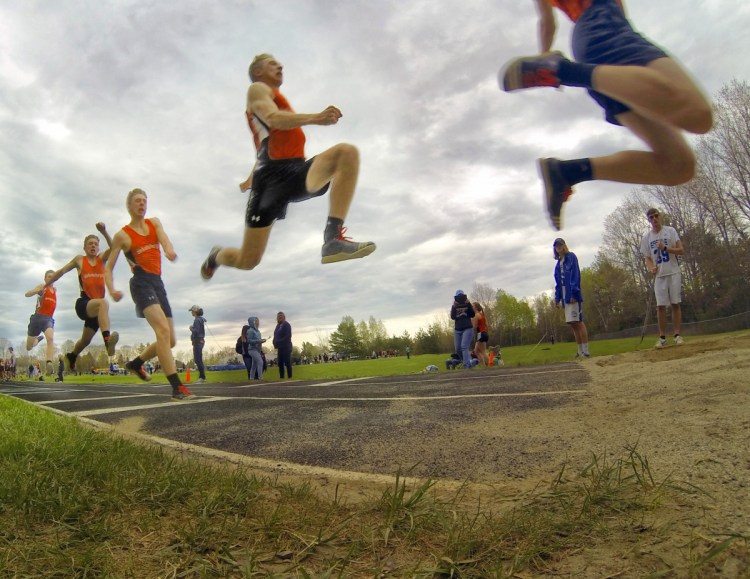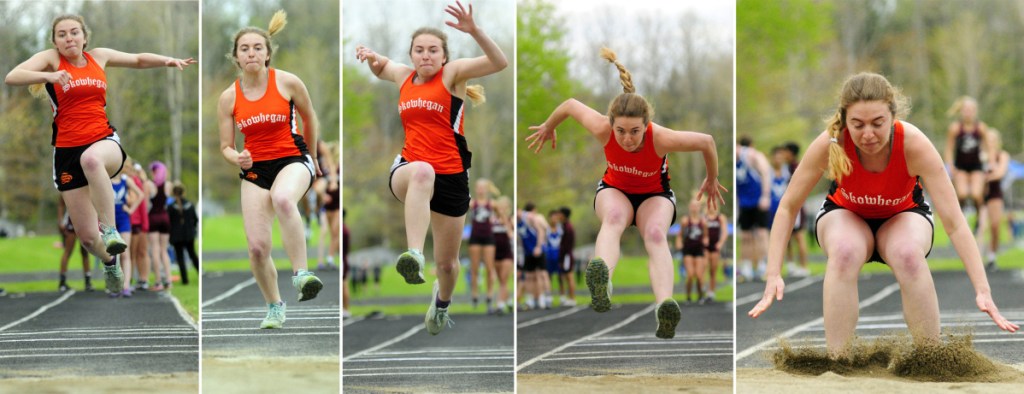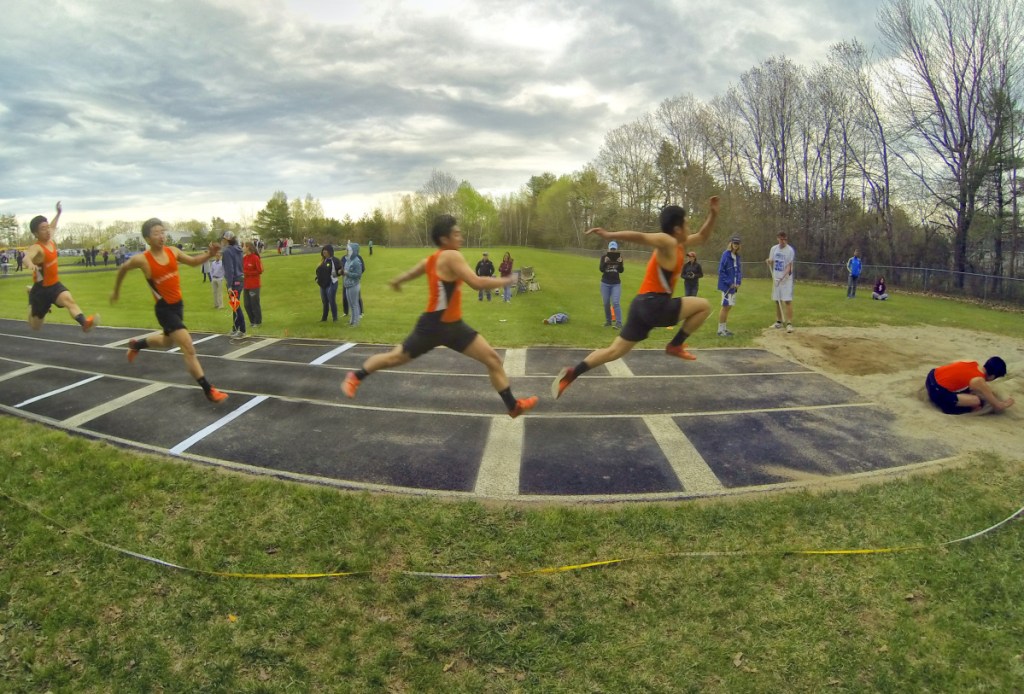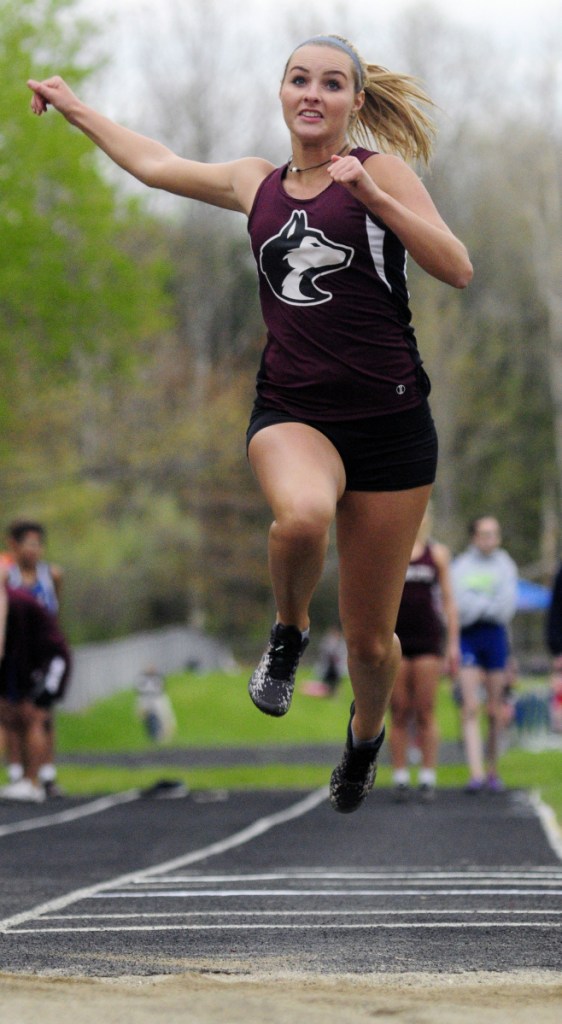READFIELD — In a sport that epitomizes athleticism, speed and strength, it’s the rare event that looks…well…awkward.
“When do you ever run and take three steps?” Winslow coach Ken Nadeau said. “When do you ever run, land on the same foot and then switch feet? I’d say it’s pretty unorthodox, for sure.”
Indeed, show up to your first track and field meet and head over to the triple jump, and you’re likely to be perplexed. None of it looks natural. Athletes race down a runway, and then it looks like their hamstrings go out. They hop forward, then skip, and then leap into a sand pit, and then they head back to try it again.
Each time, however, it looks unusual. At a track and field meet, where it’s often so apparent what athletic skill is on display, the triple jump seems like the sport’s attempt to include them all – and even those who do it say it can look baffling.
“Yeah, I definitely thought that,” Winslow’s Carly Warn said. “It took me a while to get everything down, because your legs are going in different motions all the time.”
Jumpers start by sprinting to a designated point, then hopping forward on one foot. They must land on the same foot on which they took off, then skip forward and land on the other foot, and then leap and come down on both feet in the sand. The length from where that first hop began to where the last leap ended is the jump.
It looks like there’s a stumble in the middle of the process, almost as if the athlete changed his or her mind midway through. But as clumsy as it can seem, jumpers say that’s not the way it feels.
“If you’re doing it well, it shouldn’t be,” Messalonskee’s Libby Breznyak said. “If you don’t have the right form, it can be a herky-jerky motion.”
That right form isn’t an easy one to figure out.
“It feels natural for me. … I don’t even think of it,” Waterville’s Ethan Nurick said. “I coach summer track, so when I try to explain it, it’s hard to explain. Doing it, you don’t think about it, really.”
“It did look quite difficult. I had some trouble, especially with the triple jump, remembering all the motions and how to land properly and how much height you need for each single step,” Cony’s Dustin Dyer added. “With long jump, it’s one jump. With the (triple) jump, there are multiple, and it’s kind of confusing.”
The key to triple jumping, according to those who know how, is not in attacking the whole motion at once, but in learning each step — called “phases” — one at a time.
“It helps to practice each step,” Dyer said. “Say you’re running down the track, only practice jumping off one foot first. After you get the hang of that, you practice jumping off that foot and skipping to your next one. Then you’re starting to get the hang of the pattern.”
With the motion down pat, several skills and abilities come into play to determine who the best triple jumpers will be. Nadeau, whose team won the Class B boys state title last year and boasts one of the state’s best triple jumpers in Max Spaulding, said nothing beats pure speed for generating the power needed to get the jump started.
“You’ve got to be good off both feet, you’ve got to have decent speed on the runway, good overall power to get up,” he said. “Most of the kids I have that compete well are good sprinters. … They all have the quick muscle fiber-type things to perform well. That’s the first thing I look at. Can they jump off both feet, and do they have a good tempo when they run? If they can do those things, they’re usually pretty good.”
Others point to body control as the greatest asset. Breznyak and Waterville’s Ella Ruehsen, who set a personal record by two feet in the jump Friday, were gymnasts growing up, and said that background has paid off for them in track.
“Gymnastics teaches you a lot of body control,” Breznyak said, “In triple jump you definitely need to have a lot of body control and be aware of where everything is.”
Ruehsen said that focus, specifically a steadfast belief that the muscle memory will hold up from jump to landing, is as important as any physical key.
“It takes a certain kind of mental toughness because you have to be able to trust your steps every time,” she said. “So if you’re looking at the board and thinking about your steps up to the board and trying not to fall, you’re not going to be as focused on your form during your jump.”
That form is crucial, and Nurick said it’s one of the appeals of the event. As much as it demands in terms of speed, strength and coordination, preparation can pay off as much as any physical gifts.
“I was never super strong or super fast,” he said. “Triple’s really technique, so it was easy to adjust my technique and work on that, rather than (rely) on pure strength or pure speed.
“It really is just form, and how much time you’re willing to devote to getting the perfect form.”
Drew Bonifant — 621-5638
dbonifant@centralmaine.com
Twitter: @dbonifantMTM
Copy the Story LinkSend questions/comments to the editors.







Success. Please wait for the page to reload. If the page does not reload within 5 seconds, please refresh the page.
Enter your email and password to access comments.
Hi, to comment on stories you must . This profile is in addition to your subscription and website login.
Already have a commenting profile? .
Invalid username/password.
Please check your email to confirm and complete your registration.
Only subscribers are eligible to post comments. Please subscribe or login first for digital access. Here’s why.
Use the form below to reset your password. When you've submitted your account email, we will send an email with a reset code.